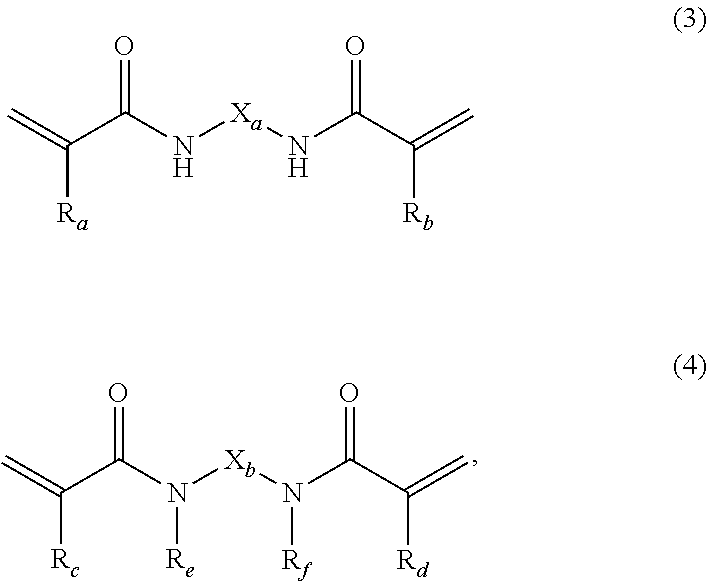Dental cement
a dental cement and multi-part technology, applied in dental prosthetics, impression caps, surgery, etc., can solve the problems of low storage stability, limited range of compositions, and (methacrylate-based polymerizable monomers, and achieve excellent adhesiveness to dentin and high mechanical strength
- Summary
- Abstract
- Description
- Claims
- Application Information
AI Technical Summary
Benefits of technology
Problems solved by technology
Method used
Image
Examples
synthesis example 1
(Synthesis Example 1) Synthesis of MAEA
[0146]172.7 g (1.5 mol) of hydroxyethyl acrylamide (manufactured by Kohjin Film & Chemicals Co., Ltd.), 167 g (1.65 mol) of triethylamine, 38 mg (0.3 mmol) of p-methoxyphenol, and 1500 mL of anhydrous tetrahydrofuran were put into a 10-liter four-necked flask, stirred, and cooled to an internal temperature of −10° C. 700 mL of an anhydrous tetrahydrofuran solution of methacrylic acid chloride (172.5 g, 1.65 mol) was added dropwise at 5° C. or lower over 2 hours. After the dropwise addition of the solution, the resulting mixture was stirred for 24 hours under the conditions of room temperature. The resulting reaction solution was filtered, and insoluble matters were washed with ethyl acetate. The filtrate was concentrated under reduced pressure, and the residue was dissolved in ethyl acetate. The resulting solution was filtered with Celite to remove a small amount of insoluble matters, and then the filtrate was washed with a mixture of saturated...
synthesis example 2
(Synthesis Example 2) Synthesis of MAPA
[0149]23.9 g (0.318 mol) of 3-aminopropanol (manufactured by Tokyo Chemical Industry Co., Ltd.) and 400 mL of anhydrous tetrahydrofuran were put into a 1-liter four-necked flask, stirred, and cooled to an internal temperature of −10° C. 70 mL of an anhydrous tetrahydrofuran solution of acrylic acid chloride (14.4 g, 0.159 mol) was added dropwise at 5° C. or lower over 30 minutes. After the dropwise addition of the solution, the resulting mixture was stirred for 1 hour under the conditions of room temperature. After the reaction, insoluble matters were filtered and removed, and the filtrate was concentrated under reduced pressure. Thus, a pale yellow liquid was obtained.
[0150]12.9 g (0.1 mol) of hydroxypropyl acrylamide obtained by the procedure described above, 200 mL of anhydrous tetrahydrofuran, and 15.2 g (0.15 mol) of triethylamine were put into a 500-milliliter four-necked flask, stirred, and cooled to an internal temperature of −10° C. 50...
synthesis example 3
(Synthesis Example 3) Synthesis of MAEEA
[0153]28.3 g (0.318 mol) of DL-2-amino-1-butanol (manufactured by Tokyo Chemical Industry Co., Ltd.) and 400 mL of anhydrous tetrahydrofuran were put into a 1-liter four-necked flask, stirred, and cooled to an internal temperature of −10° C. 70 mL of an anhydrous tetrahydrofuran solution of acrylic acid chloride (14.4 g, 0.159 mol) was added dropwise at 5° C. or lower over 30 minutes. After the dropwise addition of the solution, the resulting mixture was stirred for 1 hour under the conditions of room temperature. After the reaction, insoluble matters were filtered and removed, and the filtrate was concentrated under reduced pressure. Thus, a pale yellow liquid was obtained.
[0154]14.3 g (0.1 mol) of N-(1-ethyl-(2-hydroxy)ethyl)acrylamide obtained by the procedure described above, 200 mL of anhydrous tetrahydrofuran, and 15.2 g (0.15 mol) of triethylamine were put into a 500-milliliter four-necked flask, stirred, and cooled to an internal tempe...
PUM
| Property | Measurement | Unit |
|---|---|---|
| particle diameter | aaaaa | aaaaa |
| particle diameter | aaaaa | aaaaa |
| particle diameter | aaaaa | aaaaa |
Abstract
Description
Claims
Application Information
 Login to View More
Login to View More - R&D
- Intellectual Property
- Life Sciences
- Materials
- Tech Scout
- Unparalleled Data Quality
- Higher Quality Content
- 60% Fewer Hallucinations
Browse by: Latest US Patents, China's latest patents, Technical Efficacy Thesaurus, Application Domain, Technology Topic, Popular Technical Reports.
© 2025 PatSnap. All rights reserved.Legal|Privacy policy|Modern Slavery Act Transparency Statement|Sitemap|About US| Contact US: help@patsnap.com



